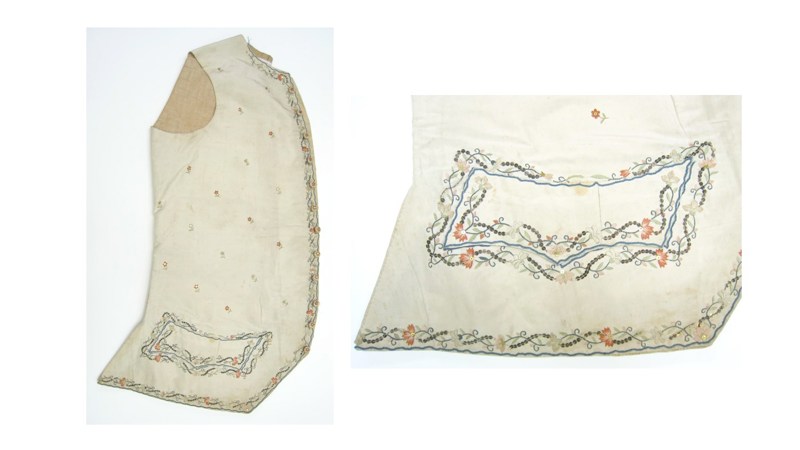A Virginian Merchant’s Waistcoat

Waistcoat said to have been embroidered by Mrs Glassels
1933.13.a
Images © CSG CIC Glasgow Museums Collection
15th February 2022
This cream silk satin waistcoat was said by the donor to have been embroidered by ‘Mrs Glassels’, the maternal grandmother of George John Douglas Campbell, 8th Duke of Argyll (1823–1900). While the majority of surviving Georgian waistcoats were embroidered professionally, there is evidence that some were stitched by amateurs to give as presents to their husbands or fathers. If Mrs Glassels did make this one, she seems to have been an accomplished needlewoman. Silk thread, in delicate shades of blue, green, red, pink and cream, has been used to embroider floral sprigs down the centre front and pockets. In addition, in the same areas, silver and silver-gilt spangles have been sewn on, which when new would have caught the light as the wearer moved.
Mrs Glassels was Helen Buchan (about 1750–1823), the daughter of John Buchan of Letham. On 18 November 1780 she married John Glassel or Glassell (1736–1806). Originally from Scotland, Glassel emigrated to Virginia in 1756, settling in Fredericksburg and becoming a merchant and trader. In 1771 he purchased The Chimneys, a large house which still stands at 623 Caroline Street. He was described by Horace Edwin Hayden in Virginia Genealogies: A Genealogy of the Glassell family of Scotland and Virginia (1891), as ‘a merchant there of large enterprises and fortune. He had branch establishments in Culpeper and Fauquier counties. There is still standing at Fredericksburg a wharf known as Glassell’s wharf, which was his property.’
One of the main commodities Glassel traded in was tobacco, one of the major crops grown and harvested on Virginian plantations by enslaved African labourers and their children. There are a few references to this area of his business in the correspondence of James Robinson, who worked for William Cunninghame and Co., one of the largest partnerships of Glasgow tobacco merchants. He was based in Falmouth, Virginia, and ran the company’s trade in Virginia, purchasing tobacco from local merchants, including Glassell. (The correspondence is transcribed in A Scottish firm in Virginia 1767–1777 W. Cuninghame and Co., edited by TM Devine, published by the Scottish History Society, 1984.) On 9 April 1770 Robinson writes that ‘Mr Balfour was up at Fredericksburg lately and bought some tobacco from J. Glassell at 20s. stg.’ Two years later, on 1 June 1772, Robinson reports on the attempts by Fredericksburg merchants to fix the price of tobacco: ‘Mr Henry Mitchell and Mr Glassell, are much piqued at the wanton manner Mr Robb has taken the lead, saying they could not support their engagements with the planters without giving them as much as they can procure in town.’ On 26 July 1774 Robinson states that ‘Simon Fraser for Urbanna bought lately 70 hogsheads at 10s. stg. from John Glassell and Daniel Payne.’
As well as trading in tobacco, Glassel also served as a transatlantic agent. The diary of John Harrower, an indentured servant in Virginia, which is now in the Colonial Williamsburg Foundation’s collection, includes references to ‘Mr John Glassell’s store’, through which Harrower sends and receives correspondence from his wife in Lerwick.
In 1775, at the beginning of the American Revolution, John Glassel returned to Scotland, passing his business interests to his brother, Andrew, who remained in Virginia. Now a wealthy man, Glassel purchased Long Niddry House, Haddington, in 1779 and married Helen Buchan on 18 November 1780. Their only child and heiress, Joanna (Joan) Glassel was born 7 June 1796. A visitor to the family in 1804, Walter Colquhoun of Glasgow, wrote to Daniel Grinnan of Fredericksburg: ‘Last month I went on a visit to my old friend, Mr Glassell, and passed eight days with him at Long Niddry, where I was treated with much friendship and hospitality. … You may believe we talked much of Virginia affairs. … Mrs. G. is an amiable, well informed woman – active, industrious, extremely attentive to her husband and to his domestic concerns. Their daughter and only child, about eight years of age, a fine looking, healthy, promising girl – she will have a handsome fortune.’
Indeed, Joan went on to inherit a vast fortune founded upon the profits of a slavery economy. With a marriage portion of £50,000 it was probably not surprising when she became the second wife of Lord John Douglas Henry Campbell, who later became 7th Duke of Argyll.
Rebecca Quinton,
Research Manager, Art
